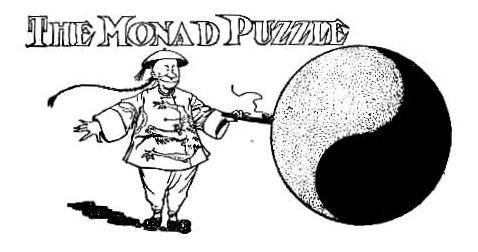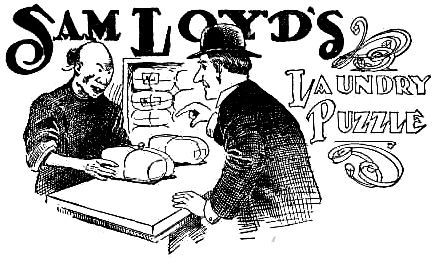



THE sign of the great Monad, which was unwittingly adopted as its seal by the Northern Pacific Railway Company, means to a Chinaman exactly what the cross does to a Christian. It is the sign of Deity, and represents eternity,—the everlasting, as Chinese scholars express it,—and is to-day an object of veneration to over 400,000,000 people.
It was adopted by the Northern Pacific Railway Company as a seal and trade-mark at the time of the organization of the company, and appears on all of its freight cars, bonds, stock certificates and advertisements, and it is familiar to everyone who has occasion to use the timetables.
It was adopted at the suggestion of Chief Henry Mc Henry, who says he had no conception of its Chinese significance, but merely intended it to represent certain mathematical proportions. This fact I have only just learned, so it will be interesting to know how far Mr. McHenry's views coincide with my own as given in the puzzle connected with it.
The best thing I ever heard about the sign was told to me by P. H. Tighe. the famous manufacturer of baseballs, who got the idea of the two-piece cover from the shape of the monad.
Attention was first called lo the significance of the symbol by Rev. W. S. Holt, who is a thorough Chinese scholar, and is familiar with its meaning through his connection with Chinese missions. Several works have been written on the symbol which prove its great antiquity, and in them are given the various interpretations put upon it. As a rule, these explanations are so mixed up with oriental theology, such, for instance, as the Yin and Yang, the male and female forces of nature, and “the illimitable as adverse to the great extreme,” that the reader feels as if he were investigating the Keely motor.
One writer on the subject is of the opinion that the sign has some recondite mathematical significance, and quotes ancient Chinese works as saying: “The illimitable produces the great extreme. The great extreme produces the two principles. The two principles produce the four quarters, and from the four figures we develop the quadrature of the eight diagrams of Feuh-hi.” This was written more than three thousand years ago. And yet, so far as I can learn, has never been connected with the mathematical “squaring of the circle,” although, it looks very much like it. And is suggestive of the following propositions:—
The first proposition is given as a simple puzzle for young folks. With one continuous line, divide the black and white parts of the Monad (the Yin and the Yang), into four pieces of the same shape and size.
The second proposition is to divide by one straight cut the Yin and the Yang, (supposing them to be two pieces already,) each into two pieces of the same size. This can also be done by those without any great mathematical ability.
The third proposition is to prove the “affinity” between the Monad and the “good-luck” sign, by converting the two horseshoes, as shown in Figures 1 and 3 below, into a perfect Monad, in the shortest possible way.

The Monad puzzle is cut into four pieces by the curved line as shown, whereas a straight cut from A to B would give 4 pieces of same size but different shapes. The horse shoes may be divided into four pieces which will fit together so as to make a perfect monad.

2. A Charade
My first, my second, and my whole.
Are every one the same;
In point of meaning, each and all.
An oft repeated name.
Mama or Papa
3.

Charlie and Freddie having sent their lingerie, consisting of thirty pieces, to the wash, Freddie calls for the same and explains that as his bundle contains half of the cuffs and but one-third of the collars, it should cost but twenty-seven cents. As four cuffs cost the same as five collars. Hop Lee, who is a poor mathematician, wants to know how much he must charge Charlie for the other package.
It can be seen that if there were thirty pieces of laundry and Freddie was charged 27 cents for half the cuffs and one-third of the collars, there must have been 12 cuffs and 18 collars, so Charlie will owe 39 cents, as collars cost 2 cents and cuffs 2 1/2 cents.
[Page 26]